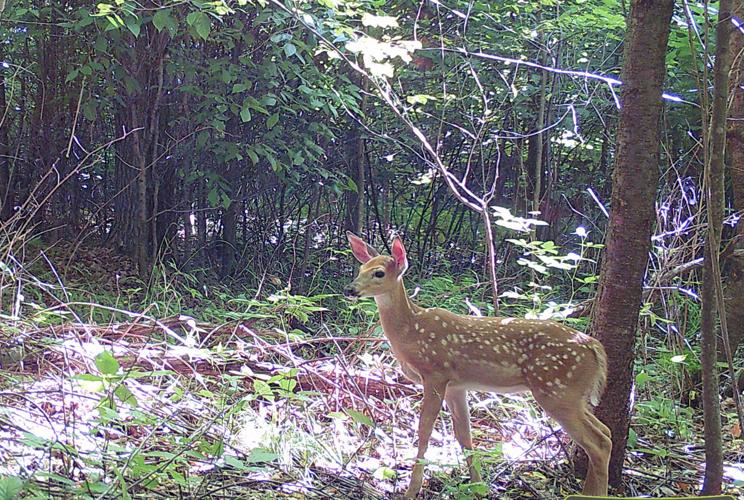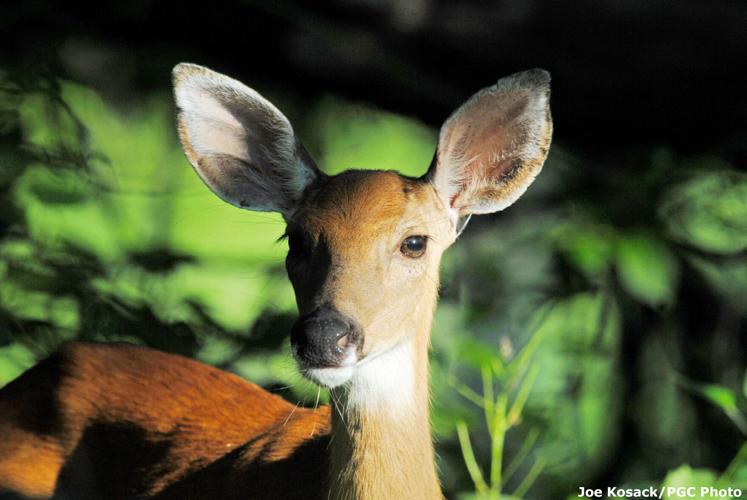Deer are easy to spot in our yards and along our roads. Why do they seem to have no fear of us? Researchers at Penn State have found that being close to humans helps deer feel safer from predators and from hunters, too.
That is just one finding of Pennsylvania’s huge Deer-Forest Study, now in its tenth year. Penn State University scientists, along with the PA Game Commission and the U.S. Geological Survey, have been tracking deer in four designated areas in central Pennsylvania to see what they eat, where they go, and how they deal with stress, especially during hunting season. The study is expected to continue until 2026.
Duane Diefenbach, of the U.S. Geological Survey, heads the project. He started studying deer in Pennsylvania over 20 years ago. Forest habitat conditions had been monitored by the PA Game Commission for long before that. In a 2022 interview broadcast by the NDA (National Deer Association), Diefenbach said that studying deer has become more complicated over time.
The four study areas range from 25-40 square miles, with two in the north, in the Susquehannock State Forest and the other two farther south, in Bald Eagle and Rothrock State Forests. The aim is to “monitor deer populations and forest changes,” according to their website at www.deer.psu.edu.
According to Sgt. Jared Turner, of the PA Game Commission, the deer in the Penn State study “are very similar to here.”
Turner, supervisor for Montour, Northumberland, and Columbia counties, said that upon arriving here seven years ago, his first impression was, “We have a lot of deer.”
He added that “Not a single hunter has complained to me about not enough deer.”
Home range
According to the Penn State study, deer don’t move around all that much, except under special circumstances. It is a pretty good rule of thumb that the home range of a buck is probably one square mile, or 640 acres, and for a doe, it is a quarter of a square mile. That is assuming plenty of available nutrition, which is not a problem locally.
“This is a good place to be a deer,” said Turner. “They have it easy.” That is because this area provides lots of good places to hide on the edge of towns and in suburban yards, which are bordered by woods and farmers’ fields.
“Where they live,” he said, “is determined by what they want to eat.”
They move from tender shoots in the spring to mature corn and soybeans in the summer and fall, with a good supply of acorns in the woods all year round. The range may expand a little if it is a drought year or the apple yield is disappointing.
“We do have high complaints of crop damage from farmers,” Turner admitted, “but I’ll never say there are too many deer.”
Hunters play a crucial role in keeping deer populations under some control, and farmers can get extra tags allowing them to take more than the normal limit of deer to help protect their crops.
The Penn State study has tracked deer behavior during rifle season and found that most contract their range rather than flee to a new location. During rutting, though, males often expand their range to two, three, or even four square miles. A pregnant doe will often travel, too, to find the perfect spot to give birth. One Deer-Forest blog posting entitled “The Human Shield,” from April 2023, reports on a doe who had her babies near the intersection of two well-traveled roads, the safest place she could find.
Tracking movement
In order to track movement in the study area, researchers must first capture and radio-collar a number of deer. Six adult does and four adult bucks from each study area are fitted with GPS collars. Each January through March, field techs work seven days a week to collar the deer needed for the coming year’s study.
Michaela Wallingford, who has been part of a capture crew for the past two years, described the process.
“First, we walk the area, looking for signs of heavy travel, and put out corn. If deer are interested, we put up a clover trap with corn inside for them to explore, and then finally set the trap.” Field techs check the traps every morning and, if occupied, send in the crew to put on the GPS collar.
Two team members, lead and back-up, enter the cage, wearing hockey helmets and COVID masks to protect themselves and the deer.
“The deer are usually calm or sleeping when we find them,” she said. “One person tucks the front legs under and the other does the back legs, and then we put a mask over the muzzle, put on the collar, and release the deer.” The whole process takes 5-10 minutes.
Scientists track the deer every day from their desktops. To conserve battery life, they track every seven hours over the summer, then every hour starting in September, and then every 20 minutes during hunting season. Batteries generally last three years if used this way, and that is about the lifespan of a deer as well. According to Diefenbach, in the NDA interview, some bucks live to be six years old. If the battery dies before the animal, they sometimes recapture the deer to change the collar.
One blog post from October 2022 called “Playing the Lottery — Part 1,” talks about life expectancy, based on 19 years of survival data. It reports that in one study area, “in 2 years, only about 20% of collared bucks are still alive,” but in another area, 42% are still alive after three years.”
Part 2 of that blog reports better results for females, with over half of adult females still alive after hunting season.
Importance of ‘forest’
Currently, the Deer-Forest Blog, accessible on the website, numbers 722 posts, going back to 2014. Wildlife biologist Jeannine Fleegle, of the PA Game Commission, along with Diefenbach, post these newsy pieces about once every two weeks all year long, on topics ranging from tick protection (“Baby and Bathwater”) to why bucks and does don’t hang out together (“Gut Feeling”). In the winter, “Deer Crew Diaries” are added to the mix.
Diefenbach said in his NDA interview that actually the word “forest” should come first in the name of the study because that is really the central focus. The mission is to “lead to better understanding of the complex relationships between our state’s deer and the forest.”
A large part of the study is plant-related. Researchers monitor plots within the study areas to document changes in vegetation over time. Study plots are in clusters of five, with one fenced as a control. This allows researchers to see how vegetation responds to changes in deer densities and forest management actions.
Starting in June, after having captured deer in the winter and monitored them using infrared technology in the spring, Wallingford begins the “forest” part of her job, surveying plant life in the plots and measuring the impact of deer on regeneration efforts.
“I love it,” she said. “Everything is so interesting. It’s good to be a part of it.”
Local challenges
Bob Stoudt, director of MARC in Montour County, is very much aware of what deer can do to a forest landscape. At Montour Preserve, with 500 acres of fields and woods plus a 155-acre lake, he estimates 50-75 deer in residence at any time.
“That’s too many deer,” he said. With no hunting at the Preserve and no dogs allowed, deer flock there from nearby farmland, which is heavily hunted. The problem for him is that “Deer will eat everything they can.”
“They eat the native shrubs and wildflowers we want, but they leave the invasive plants we don’t want,” he said.
Because of the emerald ash borer, which has destroyed the ash trees, and the voracious appetites of the deer, he sees the Goose Woods area as an “ecological disaster.” Deer will reject the Japanese barberry and the Japanese stillgrass, invasives which squeeze out new tree and shrub seedlings, but eat the good native plants as soon as they sprout.
Stoudt said there is no plan to allow hunting at Montour Preserve, but he admits that neither Hess nor Hopewell Park has the same vegetation problems, at least partly because of allowing limited hunting at Hopewell and dogs at both. “At the Preserve, with no distractions, deer might eat everything seven feet or lower in a section of the woods. They will even munch on evergreens over the winter.”
Stoudt has been an avid hunter all his life and feels that in Pennsylvania, the hunting population is aging out.
“Fewer young people are going out,’ he said, though he believes that trend reversed somewhat during the pandemic.
The Deer-Forest project sees hunters as a crucial part of this deer-forest interaction. In the areas under study, the PA Game Commission hopes to manage forests differently with the help of hunters. They ask licensed hunters who hunt in the study areas to register and complete a questionnaire about their experiences. They want to see how forest conditions “respond to real-world deer and forest management activities” now underway.




